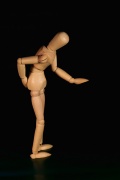Sciatica
Sciatica is due to injury or pressure on the sciatic nerve. It typically results in pain, weakness, numbness, or tingling in the affected leg.
|
Sciatica | |
| Causes | Posture, Injuries, Dehydration, Stress |
|---|---|
| See Also | Musculoskeletal Conditions |
| Books | Books on Muscle, Joint and Bone Conditions |
| Articles | Articles on Musculoskeletal Conditions |
Contents
Naturopathic Assessment
Causal Factors
In order to stimulate the innate ability of the body to heal the causes of disease must be identified and addressed. With sciatica, the causes are variable and include posture and injury. A detailed assessment is required to determine which factors are contributing to sciatica.
Lifestyle
- Posture
- Sitting or standing routinely for long periods can lead to sciatica.[1]
- Dehydration can lead to a decrease in the volume of the inter-vertebral disks. This makes them more prone to dislocation especially when weight is being applied to the spine, as when lifting heavy objects. When inter-vertebral disks dislocate they can put pressure on spinal nerves which can cause sciatica.[2]
Social
External
- Trauma
- Irritation or compression of the sciatic nerve leads to sciatica.[1]
Diagnostic Testing
The diagnosis of sciatica is often based on a person's symptoms and physical exam. Other diagnostic tests can include:
- Imaging studies such as X-rays and MRIs.
Related Symptoms and Conditions
Sciatica is often associated with:* Common causes of this are:[1]
- herniated or ruptured lumbar discs
- Piriformis syndrome (a pain disorder involving the narrow muscle in the buttocks)
- Pelvic injury or fracture
- Tumors
- lumbrosacral muscle strain
- spinal stenosis
- arthritis
- endometrial cysts
- ankylosing spondylitis
- sacroiliac ligament tear
- weak abdominal and back muscles
Characteristics
The sciatic nerve originates in the lower spine and runs down the back of each leg. The sciatica nerve controls the muscles of the back of the knee and lower leg and provides sensation to the back of the thigh, part of the lower leg, and the sole of the foot.
Sciatica is characterized by:[1]
- constant or intermittent pain that is either sudden or progressive.
- Pain typically feels sharp, stabbing, electrical, or burning.
- Numbness, weakness, tingling and aches, can also be felt along the pathway of the sciatic nerve.
Call your doctor right away if you have:[3]
- Unexplained fever with back pain
- Back pain after a severe blow or fall
- Redness or swelling on the back or spine
- Pain traveling down your legs below the knee
- Weakness or numbness in your buttocks, thigh, leg, or pelvis
- Burning with urination or blood in your urine
- Pain that is worse when you lie down, or awakens you at night
- Severe pain and you cannot get comfortable
- Loss of control of urine or stool (incontinence)
Naturopathic Treatment
The goal of naturopathic treatment is to support and work in tandem with the healing power of the body and to address the causal factors of disease with individual treatment strategies. Sciatica is typically an acute disease, yet if often reoccurs.
It is always advisable to work with a naturopathic doctor before engaging in any treatment plan.
Lifestyle
Lifestyle recommendations include:
- Dietary recommendations
- Ensure you drink adequate water.
- Stretching exercises, especially when used at the onset of symptoms, can dramatically help reduce the pain and discomfort associated with sciatica.
- Ongoing exercise is beneficial to prevent sciatica.
- Avoid sitting or standing routinely for long periods.
- Proper posture while standing, sitting and even sleeping can help prevent and treat sciatica.
- Practice abdominal / diaphragmatic breathing.
Naturopathic Therapies
Naturopathic Therapies for sciatica include:
- Botanical remedies such as Bilberry (Vaccinum myrtillus), Ginkgo (Ginkgo biloba), Horse Chestnut (Aesculus hippocastanum), St. John's Wort (Hypericum perforatum).[4], [5]
- Homeopathic remedies such as Ammonium mur, Arsenicum, Chamomilla, Colocynthis, Phytolacca, Rhus tox.[6], [7]
- According to TCM theory, sciatica occurs when there is an obstruction in the gallbladder, urinary bladder, or kidney, meridians. Obstructions within meridians lead to the poor circulation of blood and Qi. Obstructions can be caused when cold, wind or dampness invade the body and become lodged in the meridians. Acupressure and acupuncture can be used to remove obstructions in the flow of Qi along the meridians. When the flow of Qi is unenhibited, healing energy reaches he tissues, and muscles and ligaments relax. This decreases sciatic nerve pressure irritation.[1]
- The sciatic nerve is vulnerable to pressure from a mispositioned spinal column. Thus, correcting spinal misalignment can alleviate sciatic nerve entrapment, or compression.[1]
- When muscles are overused, they undergo micro-trauma. This leads to tight and irritated muscles which can put pressure on the sciatic nerve. Massage can decrease this pressure applied by muscles to the sciatic nerve by increasing blood circulation thereby facilitating blood and oxygen delivery, and the removal of waste products. This speeds muscle healing, and lengthens connective tissue, alleviating pressure on the sciatic nerve[1]
References
Co-Authored by:
- Dr. Iva Lloyd, BScH, RPE [1]
- Dr. Raymond Trott, ND
- ↑ 1.0 1.1 1.2 1.3 1.4 1.5 1.6 1.7 Credit Larry, Hartunian Sharan, Nowak Margaret. (2000). Relieving Sciatica Avery.
- ↑ Batmanghelidj F. (1997). Water, for a Healthier Pain-Free Life Audio Recording. Tape 7 side A. Global Health Solutions inc.
- ↑ http://www.ncbi.nlm.nih.gov/pubmedhealth/PMH0001706/
- ↑ Godfrey Anthony, Saunders Paul Richard, Barlow Kerry, Gilbert Cyndi, Gowan Matthew, Smith Fraser 2010 Principles and Practices of Naturopathic Botanical Medicine, Vol 1: Botanical Medicine Monographs, CCNM Press, Toronto
- ↑ Boon Heather, Smith Michael 2004 The Complete Natural Medicine Guide to the 50 Most Common Medicinal Herbs, Robert Rose, Toronto
- ↑ Hershoff Asa 2000 Homeopathic Remedies, A Quick and Easy Guide to Common Disorders and their Homeopathic Treatments, Avery Publishing Group, New York
- ↑ Ullman Robert, Reichenberg-Ullman Judyth 1997, Homeopathic Self-Care, the quick and easy guide for the whole family. Prima Publishing
